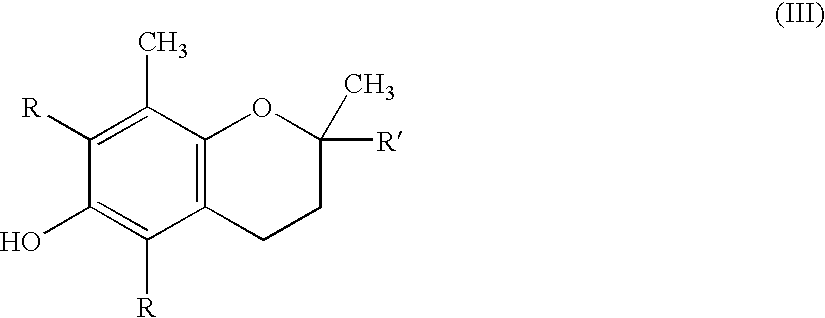Processes for preparing solid tocopherol succinate calcium and magnesium salts
a technology of tocopherol succinate and which is applied in the field of preparation of solid tocopherol succinate calcium and magnesium salt, can solve the problems of inability to meet the application requirements of tocopherol succinate, the separation of the product from the residual carboxylic acid is less than ideal, and the existing methods for producing tocopherol succinate from dibasic acid hemiester and calcium starting materials are expensive and/or inefficient, etc. problems, to achiev
- Summary
- Abstract
- Description
- Claims
- Application Information
AI Technical Summary
Benefits of technology
Problems solved by technology
Method used
Image
Examples
example 1
Preparation of α-Tocopheryl Calcium Succinate (TCS)
1.1. Reactor: 500-mL 3 or 4-necked round bottomed flask with a condenser, a thermocouple and a mechanical stirrer.
1.2. Raw Materials: α-tocopheryl succinic acid (“TSA”, Cognis Corp.), anhydrous calcium hydroxide (98+%, Acros), and methanol (HPLC grade). The methanol contained from 0.01% to 0.05% water.
[0030]
TABLE 1MaterialMW (g / mol)Quantity(g) / MolesTSA530.553.08 / 0.100Calcium hydroxide74.09 4.07 / 0.055Methanol32.04(100 + 40)gNote:Molecular weight of the expected product TCS, 1100.0 g / mol
1.3. Experimental Procedure[0031](1) The 500 mL three-neck round bottom flask is charged with 53.08 g TSA (0.100 mol), 4.07 g calcium hydroxide (0.055 mol) and 100 g methanol at ambient. temperature.[0032](2) The agitator is activated at 300 rpm and the mixture is heated to 60° C.[0033](3) The reaction mixture is held at about 60° C. for about two hours.[0034](4) After the two hours, the reactor is cooled to a temperature of about 40–45° C.[0035](5) Th...
example 2
[0038]53.2 g (0.100 moles) of d-α-tocopherol succinic acid (TSA) and 250 ml of methanol were combined in a 500 ml 3-neck glass flask, which was equipped with a mechanical stirrer, a thermometer, and a condenser. The mixture was heated to about 30° C. The TSA dissolved in the methanol at about 28° C. Subsequently, 3.15 g (0.056 moles) of calcium oxide were added to the flask at about 30° C. In this example, 0.100 moles of TSA and 0.056 moles of calcium oxide equates to a Ca2+ / TSA equivalent ratio of (0.056·2):0.100, or 1.120. The reaction temperature was then raised to about 58–60° C., and held in that temperature range for about 2 hours. The reaction mixture was then allowed to cool to room temperature (about 25° C.). The solid product was removed from the methanol by filtration, and dried under vacuum (≈100 mm Hg) at 50–55° C. for about 24 hours. The solid was analyzed via infrared spectrometry, calcium analysis and solubility testing and determined to be the calcium salt of tocoph...
example 3
[0039]53.07 g (0.100 moles) of d-α-tocopherol succinic acid (TSA), 4.11 g (0.05545 moles) of calcium hydroxide (Ca(OH)2) and 230 ml of methanol were placed in a 500 ml 3-neck glass flask, which was equipped with a mechanical stirrer, a thermometer, and a condenser. In this example, 0.100 moles of TSA and 0.055 moles of calcium hydroxide equates to a Ca2+ / TSA equivalent ratio of (0.05545·2):0.100, or 1.109. The reaction temperature was then raised to about 58–60° C., and held in that temperature range for about 2 hours. The reaction mixture was then allowed to cool to room temperature (about 25° C.). The solid product was removed from the methanol by filtration. The solid product was dried under vacuum (≈100 mm Hg) at 50–55° C. for 24 hours. The solid was analyzed via infrared spectrometry, calcium analysis and solubility testing and determined to be the calcium salt of tocopherol succinate. 54.4 g product were obtained.
PUM
| Property | Measurement | Unit |
|---|---|---|
| temperature | aaaaa | aaaaa |
| temperature | aaaaa | aaaaa |
| temperature | aaaaa | aaaaa |
Abstract
Description
Claims
Application Information
 Login to View More
Login to View More - R&D
- Intellectual Property
- Life Sciences
- Materials
- Tech Scout
- Unparalleled Data Quality
- Higher Quality Content
- 60% Fewer Hallucinations
Browse by: Latest US Patents, China's latest patents, Technical Efficacy Thesaurus, Application Domain, Technology Topic, Popular Technical Reports.
© 2025 PatSnap. All rights reserved.Legal|Privacy policy|Modern Slavery Act Transparency Statement|Sitemap|About US| Contact US: help@patsnap.com

